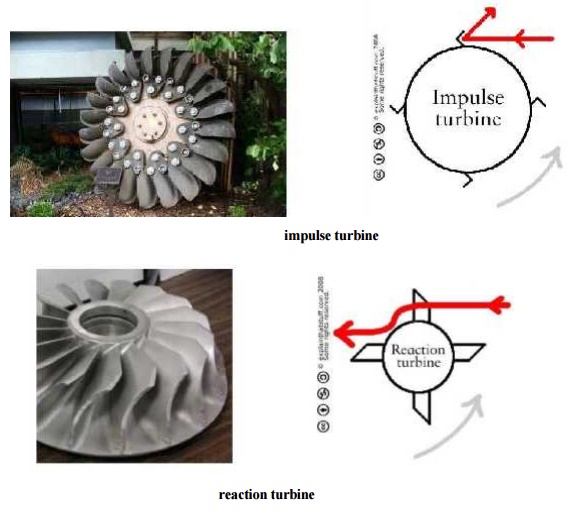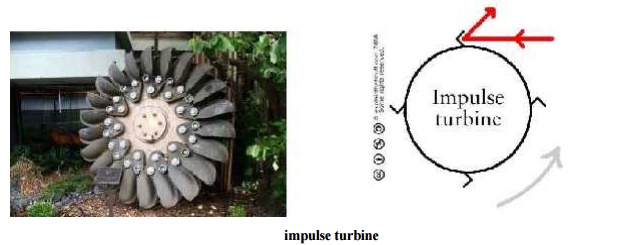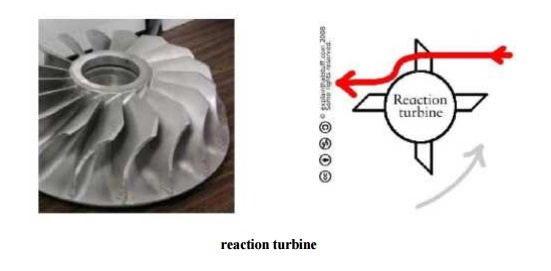Chapter: civil : Applied Hydraulic Engineering: Turbines
Classification of Turbines

Classification of Turbines
Introduction
Most of the electrical
generators are powered by turbines. Turbines are the primemovers of
civilisation. Steam and Gas turbines share in the electrical power generation
is about 75%. About 20% of power is generated by hydraulic turbines and hence
thier importance. Rest of 5% only is by other means of generation.
Hydraulic power depends on
renewable source and hence is ever lasting. It is also non polluting in terms
of non generation of carbon dioxide.
Breaking Jet
When the nozzle is
completely closed, the amount of water striking the runner reduces to zero but
the runner due to inertia goes on revolving for a long time to stop the runner
in a short time a small nozzle is provided which direct the jet of water on the
back of vanes .This jet of water is called breaking jet.
Classification of Turbines
The main classification
depends upon the type of action of the water on the turbine. These are
(i) Impulse turbine
(ii) Reaction Turbine.
(i) In the case of
impulse turbine all the potential energy is converted to kinetic energy in the
nozzles. The impulse provided by the jets is used to turn the turbine wheel.
The pressure inside the turbine is atmospheric.
This type is found suitable
when the available potential energy is high and the flow available is
comparatively low. Some people call this type as tangential flow units. Later
discussion will show under what conditions this type is chosen for operation.
(ii) In reaction
turbines the available potential energy is progressively converted in the
turbines rotors and the reaction of the accelerating water causes the turning
of the wheel.
These are again divided into radial flow, mixed flow and axial flow machines. Radial flow machines are found suitable for moderate levels of potential energy and medium quantities of flow. The axial machines are suitable for low levels of potential energy and large flow rates. The potential energy available is generally denoted as 'head available'. With this terminology plants are designated as 'high head', 'medium head' and 'low head' plants.
Impulse
and reaction turbines
Turbines
work in two different ways described as impulse and reaction terms that are
often very
confusingly described (and sometimes
completely muddled up) when people try to explain them. So what's the
difference?
Impulse
turbines
In an
impulse turbine, a fast-moving fluid is fired through a narrow nozzle at the
turbine blades to make them spin around. The blades of an impulse turbine are
usually buck et-shaped so they catch the fluid and direct it off at an angle or
sometimes even back the way it came (because that gives the most efficient
transfer of energy from the fluid to the turbine). In an impulse turbine, the
fluid is forced to hit the turbine at high speed. Imagine trying to make a
wheel like this turn around by kicking soccer balls into its paddles. You'd
need the balls to hit hard and bounce back well to get the wheel spinning-and
those constant energy impulses are the key to how it works.

Reaction
turbines
In a
reaction turbine, the blades sit in a much larger volume of fluid and turn
around as the fluid flows past them. A reaction turbine doesn't change the
direction of the fluid flow as drastically as an impulse turbine: it simply
spins as the fluid pushes through and past its blades
If an
impulse turbine is a bit like kicking soccer balls, a reaction turbine is more
like swimming-in reverse. Let me explain! Think of how you do freestyle (front
crawl) by hauling your arms through the water, starting with each hand as far
in front as you can reach and ending with a "follow through" that
throws your arm well behind you.

What
you're trying to achieve is to keep your hand and forearm pushing against the
water for as long as possible, so you transfer as much energy as you can in
each stroke. A reaction turbine is using the same idea in reverse: imagine
fast-flowing water moving past you so it makes your arms and legs move and
supplies energy to your body! With a reaction turbine, you want the water to
touch the blades smoothly, for as long as it can, so it gives up as much energy
as possible. The water isn't hitting the blades and bouncing off, as it does in
an impulse turbine: instead, the blades are movin g more smoothly, "going
with the flow".
Related Topics